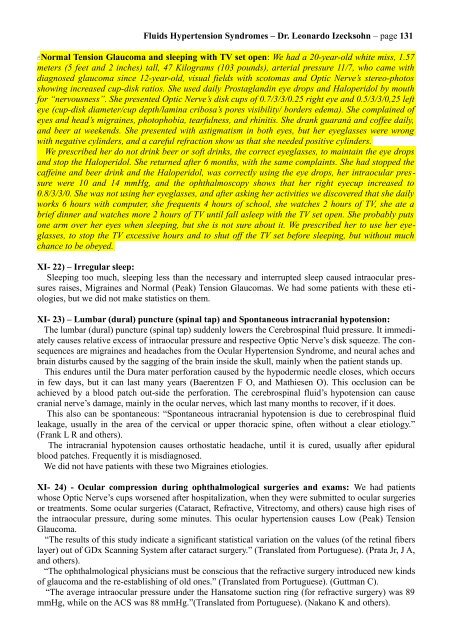Fluids Hypertension Syndromes: Migraines, Headaches, Normal ...
Fluids Hypertension Syndromes: Migraines, Headaches, Normal ...
Fluids Hypertension Syndromes: Migraines, Headaches, Normal ...
Create successful ePaper yourself
Turn your PDF publications into a flip-book with our unique Google optimized e-Paper software.
<strong>Fluids</strong> <strong>Hypertension</strong> <strong>Syndromes</strong> – Dr. Leonardo Izecksohn – page 131<br />
<strong>Normal</strong> Tension Glaucoma and sleeping with TV set open: We had a 20-year-old white miss, 1.57<br />
meters (5 feet and 2 inches) tall, 47 Kilograms (103 pounds), arterial pressure 11/7, who came with<br />
diagnosed glaucoma since 12-year-old, visual fields with scotomas and Optic Nerve’s stereo-photos<br />
showing increased cup-disk ratios. She used daily Prostaglandin eye drops and Haloperidol by mouth<br />
for “nervousness”. She presented Optic Nerve’s disk cups of 0.7/3/3/0.25 right eye and 0.5/3/3/0,25 left<br />
eye (cup-disk diameter/cup depth/lamina cribosa’s pores visibility/ borders edema). She complained of<br />
eyes and head’s migraines, photophobia, tearfulness, and rhinitis. She drank guaraná and coffee daily,<br />
and beer at weekends. She presented with astigmatism in both eyes, but her eyeglasses were wrong<br />
with negative cylinders, and a careful refraction show us that she needed positive cylinders.<br />
We prescribed her do not drink beer or soft drinks, the correct eyeglasses, to maintain the eye drops<br />
and stop the Haloperidol. She returned after 6 months, with the same complaints. She had stopped the<br />
caffeine and beer drink and the Haloperidol, was correctly using the eye drops, her intraocular pressure<br />
were 10 and 14 mmHg, and the ophthalmoscopy shows that her right eyecup increased to<br />
0.8/3/3/0. She was not using her eyeglasses, and after asking her activities we discovered that she daily<br />
works 6 hours with computer, she frequents 4 hours of school, she watches 2 hours of TV, she ate a<br />
brief dinner and watches more 2 hours of TV until fall asleep with the TV set open. She probably puts<br />
one arm over her eyes when sleeping, but she is not sure about it. We prescribed her to use her eyeglasses,<br />
to stop the TV excessive hours and to shut off the TV set before sleeping, but without much<br />
chance to be obeyed.<br />
XI- 22) – Irregular sleep:<br />
Sleeping too much, sleeping less than the necessary and interrupted sleep caused intraocular pressures<br />
raises, <strong>Migraines</strong> and <strong>Normal</strong> (Peak) Tension Glaucomas. We had some patients with these etiologies,<br />
but we did not make statistics on them.<br />
XI- 23) – Lumbar (dural) puncture (spinal tap) and Spontaneous intracranial hypotension:<br />
The lumbar (dural) puncture (spinal tap) suddenly lowers the Cerebrospinal fluid pressure. It immediately<br />
causes relative excess of intraocular pressure and respective Optic Nerve’s disk squeeze. The consequences<br />
are migraines and headaches from the Ocular <strong>Hypertension</strong> Syndrome, and neural aches and<br />
brain disturbs caused by the sagging of the brain inside the skull, mainly when the patient stands up.<br />
This endures until the Dura mater perforation caused by the hypodermic needle closes, which occurs<br />
in few days, but it can last many years (Baerentzen F O, and Mathiesen O). This occlusion can be<br />
achieved by a blood patch out-side the perforation. The cerebrospinal fluid’s hypotension can cause<br />
cranial nerve’s damage, mainly in the ocular nerves, which last many months to recover, if it does.<br />
This also can be spontaneous: “Spontaneous intracranial hypotension is due to cerebrospinal fluid<br />
leakage, usually in the area of the cervical or upper thoracic spine, often without a clear etiology.”<br />
(Frank L R and others).<br />
The intracranial hypotension causes orthostatic headache, until it is cured, usually after epidural<br />
blood patches. Frequently it is misdiagnosed.<br />
We did not have patients with these two <strong>Migraines</strong> etiologies.<br />
XI- 24) - Ocular compression during ophthalmological surgeries and exams: We had patients<br />
whose Optic Nerve’s cups worsened after hospitalization, when they were submitted to ocular surgeries<br />
or treatments. Some ocular surgeries (Cataract, Refractive, Vitrectomy, and others) cause high rises of<br />
the intraocular pressure, during some minutes. This ocular hypertension causes Low (Peak) Tension<br />
Glaucoma.<br />
“The results of this study indicate a significant statistical variation on the values (of the retinal fibers<br />
layer) out of GDx Scanning System after cataract surgery.” (Translated from Portuguese). (Prata Jr, J A,<br />
and others).<br />
“The ophthalmological physicians must be conscious that the refractive surgery introduced new kinds<br />
of glaucoma and the re-establishing of old ones.” (Translated from Portuguese). (Guttman C).<br />
“The average intraocular pressure under the Hansatome suction ring (for refractive surgery) was 89<br />
mmHg, while on the ACS was 88 mmHg.”(Translated from Portuguese). (Nakano K and others).


